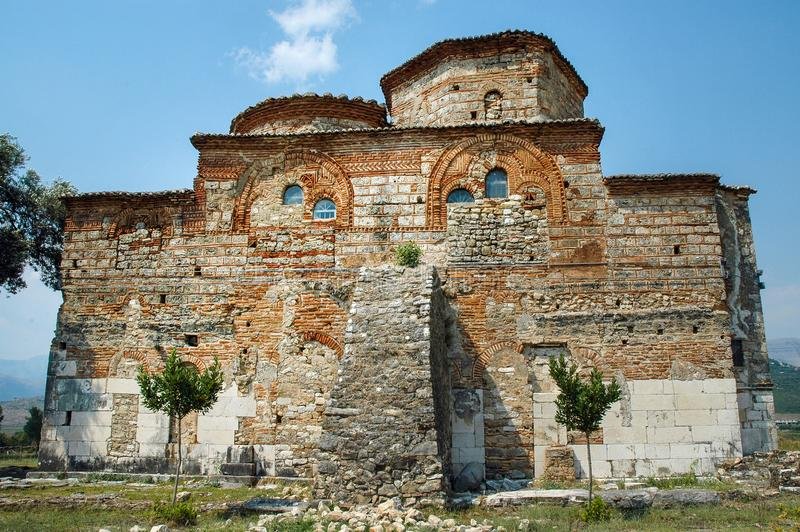Discover what Albania offers
1) Synagogue Complex
Impressive remains of a 5th or 6th century AD synagogue have been uncovered in the coastal city of Saranda, Albania, which lies just opposite the Greek island of Corfu.
Initial excavations at the site were conducted some 20 years ago when Albania was under tight Communist rule. However, the remains of this religious structure have only just seen the light during joint excavations by the Albanian Academy of Sciences and the Hebrew University Institute of Archaeology.


2) Butrint
Butrint, located in the south of Albania approximately 20km from the modern city of Saranda, has a special atmosphere created by a combination of archaeology, monuments and nature in the Mediterranean. Nhabited since prehistoric times, Butrint has been the site of a Greek colony, a Roman city and a bishopric. Following a period of prosperity under Byzantine administration, then a brief occupation by the Venetians, the city was abandoned in the late Middle Ages after marshes formed in the area. The present archaeological site is a repository of ruins representing each period in the city’s development.

3) Lekuresi Castle
Lëkurësi Castle was built in 1537 by Sultan Suleiman the Magnificent of the Ottoman Empire. It was built in order to defend against the Venetians. It held a garrison of 220 soldiers as well. The region traditionally belonged to the southern part of the region of Himara. At the end of the 18th century the castle was attacked by Ali Pasha of Ioannina and the surrounding habitation raided.
The castle used to withhold the old Lëkurës village. It has a square shape with two round towers on its north-western and south-eastern corners. To climb up to the castle, visitors need to leave the main road on Qafë Gjashtë and go up the town hill from the other side of the town.
4) Blue Eye
The “Blue Eye” (Albanian: Syri i Kaltër) is a water spring and natural phenomenon occurring near the village of Muzinë in Finiq municipality, southern Albania. A popular tourist attraction, the clear blue water of the river can be seen from a depth of more than fifty metres. Divers have descended to fifty metres, but it is still unclear what the actual depth of the karst hole is
This phenomenon is also known as ‘springs of Bistricë’ as it is the initial water source of Bistricë river, 25 km long, which ends in the Ionian Sea south of Sarandë. The source stands at an altitude of 152 m and has a discharge rate of 18400 L/s.


5) The Monastery Of 40 Saints
The monastery was built in the 6th century AD as an important Byzantine pilgrimage site. It was named after the Forty Martyrs of Sebaste, which is also why it included 40 rooms, one for each of the martyrs. The legend tells that a group of Roman soldiers were asked to renounce their Christian religion in exchange for shelter. They kept loyal to their faith and refused upon which they were killed as martyrs near the city of Sebaste in Armenia.
The monastery has played an important role in the history of Saranda by giving the city its initial name, Agi Saranda, which means “Forty Saints” in Greek. Later the name was shortened by removing “Agi” and only keeping Saranda (forty).
6) The Phoenice Archaeological Park
The Phoenice Archaeological Park (Parku Arkeologjik Finiq) is an archaeological excavation of an ancient greek city located next to the village that is nowadays Finiq.
Phoenice (also called Phoenike or Φοινίκη in Greek) was the capital of the Greek tribe of the Chaonians and was once the wealthiest city in the Epirus. Due to its strategic location and economic development the city played an important strategic role from a political and administrative perspective.

7)The Saint Nicholas Monastery Church
Just outside the village of Mesopotam there is the Saint Nicholas Monastery, a 11th century church that was built on the site of an earlier orthodox monastery complex. Some of the blocks that make part of the rear wall are thought to pre-date the arrival of Christianity because of its incurved images of an eagle, a lion, a dragon and a strange mythical creature that looks like it’s strangling itself with its tail.


8) Ksamil beach
(Ksamili in Albanian) is one of the most popular destinations in the region and not without a reason. It has beautiful sand beaches and several small islands that you can even swim too and despite still being a hidden gem, it is one the best beach destinations in Europe. In this guide you can find everything you need to know before visiting Ksamil.
9) Pulëbardha Beach
Pulëbardha Beach actually means seagull’s beach. The beach is an amazing oasis that is both quiet and secluded, but still has everything you need at the same time. It’s hidden and surrounded by a rocky, but green landscape and the turquoise colored water is extremely clear. It’s a perfect place to escape the town and relax while enjoying the beautiful views.

